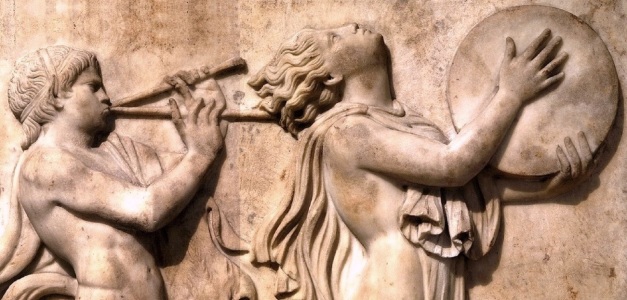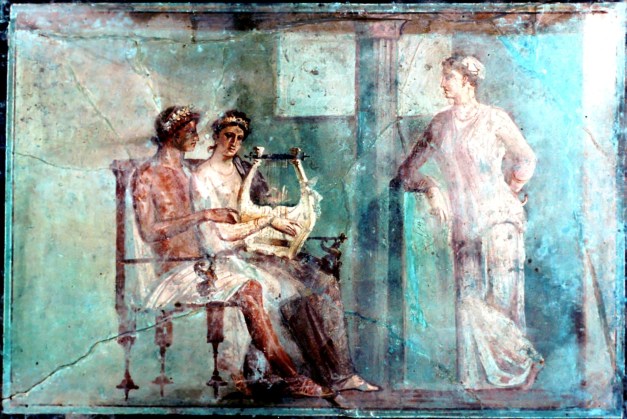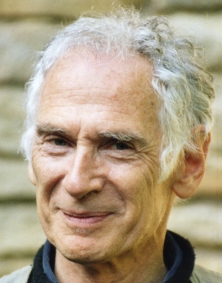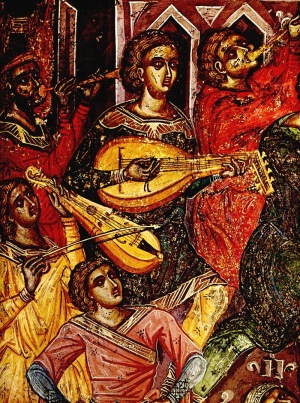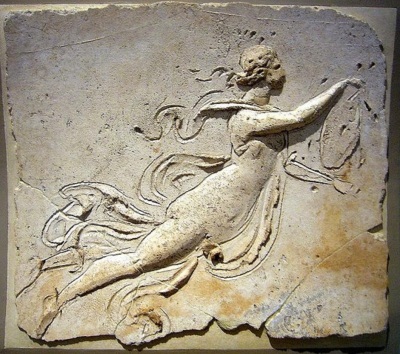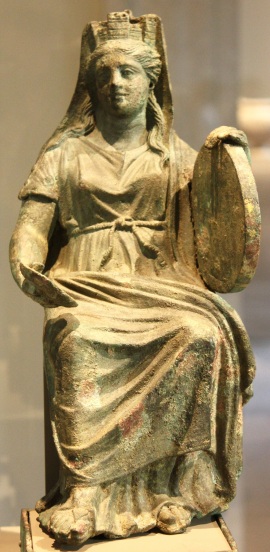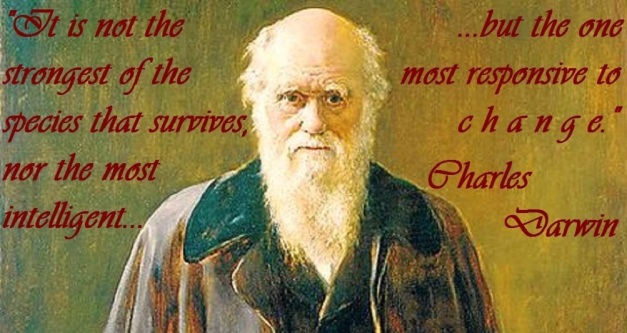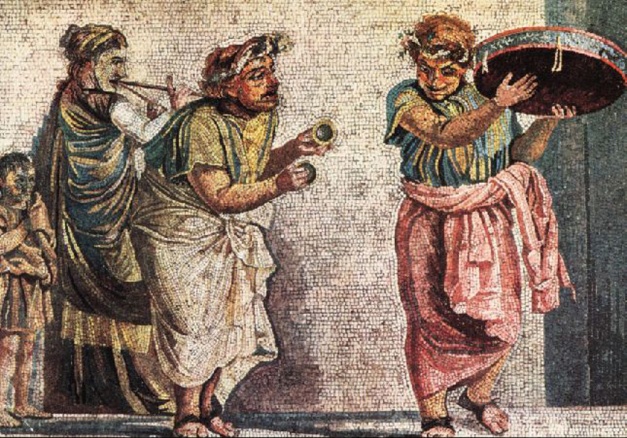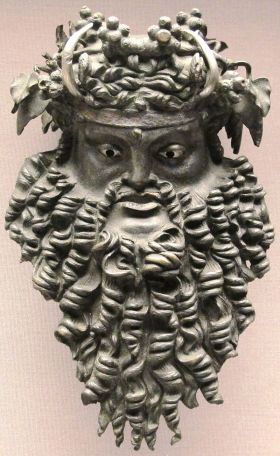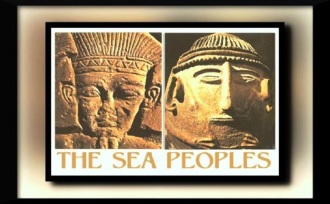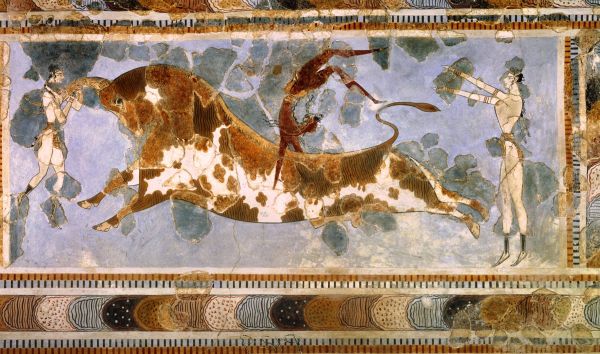Chronicle 14. MUSIC MADE OF BODY AND SOUL
/ΕΛΛΗΝΙΚΑ/ Χρονικό 14. ΜΟΥΣΙΚΗ ΨΥΧῌ ΤΕ ΚΑΙ ΣΩΜΑΤΙ
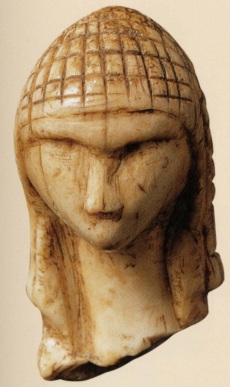
Venus of Brassempouy: mammoth ivory figurine, one of the oldest human face representations (23.000 BCE)
● Man: a Musical Being ● Nature, Music
and Language ● Singing Neanderthals ●
Baby Talk ● Talent ● Art of Soul vs. Art of
Beauty ● Ecstasy and Catharsis ● Ritual
Music and Dance ● Ethos of Music
“It is not the strongest of the species that survives, nor the most intelligent, but
the one most responsive to change”.
(Charles Darwin)
MAN IS BY NATURE A MUSICAL BEING; meaning that song, i.e. music and lyrics combined, together with movement, or dance, has always been a fundamental human characteristic, serving his various needs. Besides, music, speech, and dance, a “Holy Trinity” according to the poet Kostēs Palamās, show how close the relationship between sound, body and soul is.
Music, speech, dance: a “Holy Trinity” (Kōstēs Palamās)
Quite strange is that the ancients, even the primitives, felt the impact of musical sound onto their bodies much more intensely than modern humans. Obviously, Christianism and Occidental mentality are largely responsible for the enormous degradation of our senses. Thus experts of many disciplines are now required to work together in order to fully comprehend this subject in depth.
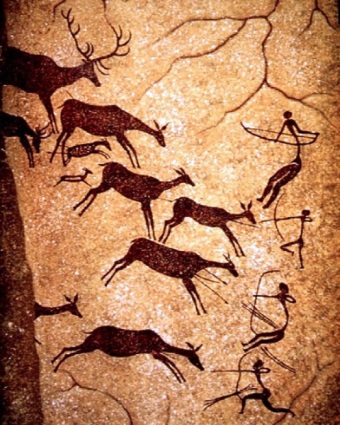
Hunting scenes in a Lascaux cave painting
Natural sounds played a key role in the genesis of music: the sounds of Nature constituted the raw “materials” that gradually began to take shape. According to Darwin, a primary stimulus was animal cries, especially during breeding season, when an orgasm of sounds and movements prevailed, so rich and varied that man inevitably imitated, responding to that exquisite call of Nature’s Choir. Yet, man, as a species of the animal kingdom, had congenitally his own “repertoire”, which he gradually enriched – initially by imitation, and later by inspiration.
The emergence of art was directly linked to elementary manifestations of magic, even before the latter was systematized as a form of religion. Cave paintings, of a much later period compared to music, are examples of utilitarian art: men tried to exorcise all the animals they depicted so as to have plenty of game, or propitiate their spirits, if they were awe-inspiring beasts, and gain their powers. That is why the cave paintings are usually found not in the “living rooms” of the caves, but deep inside, in the “sanctuaries”, where, according to Iégor Reznikoff, the areas are most resonant: it seems they were their “icons”…
Spirit propitiation had broader applications, especially to natural phenomena that seemed supernatural, or during work time to coordinate movements, or even to master the “spirit” of the stone or wood that man wished to turn into a tool. Music played a key role in such cases though it was lost in the mist of time. Today, millennia later, we can comfortably admire the cavemen’s performances in visual arts. But who has ever listened to their songs?
The question above is rather rhetoric. Still, there’s another one that is crucial to be answered:
What is music? What’s its origin?
MUSIC IS FOUND EVERYWHERE, in every culture or civilization, even the most isolated tribes: it is a feature of the human species – perhaps of other species, as well. Moreover, music is influenced by all aspects of a culture or civilization, including socio-economic organization, lifestyle, climate, technology… Emotions and ideas expressed through music, the circumstances in which it is played, the attitudes toward musicians and composers – all these vary according to space and time.
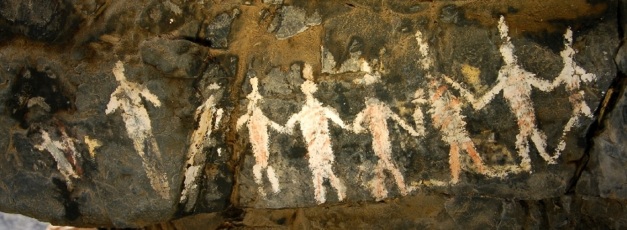
Indian Ghost Dance in eastern California: the figures form a circle dance.
As we have said, music had probably its origin in Nature’s sounds and rhythms. Men most likely imitated these phenomena using similar patterns with repetition and tonality. There are musicians who deliberately imitate natural sounds: folk fiddlers trill like birds, while Beethoven’s “Pastoral” 6th Symphony recreates the soundscape of a thunderstorm. Onomatopoeia is at times related to shamanistic beliefs or practices.(1) It also serves entertainment and edutainment, or practical purposes (such as lure of animals in hunt).
- (1) A shaman is a person regarded as having access to the “world of spirits”, entering into a trance state (very different from normal waking consciousness), and acting as a diviner or healer.
-
● Hugo Riemann, a theorist and composer, in his Catechism of Musical Aesthetics (How do we listen to music?, 1890), [Katechismus der Musik-Ästhetik (Wie hören wir Musik?)], thinks that the song of birds approaches true music and cannot be treated separately from human song, since both are the expressions of a single sensibility; while Louis Lucas, in his New Acoustics (Acoustique Nouvelle, 1840), discusses (what he calls) excellence of the enharmonic genus, and says: “It makes its first appearance naturally, as an imitation of bird song, of animal calls, and of the endless range of sounds made by material things.” Manuel de Falla was greatly influenced by Lucas and his Acoustics in his mature compositions.
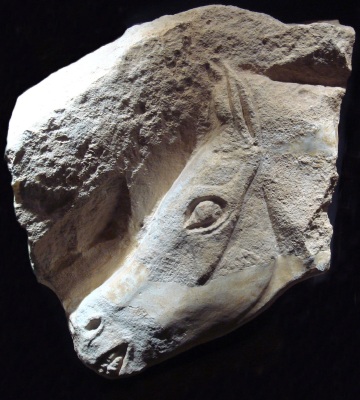
Magdalenian horse (15.000-10.000 BCE):
a game, long before it was tamed.
If the imitation of a bird song is considered music, then the bird song itself may also be regarded as music! Indeed, according to a study of zoomusicology,(2) bird songs are based on musical principles: those of repetition and transformation. It’s not only birds: whales and dolphins have also exceptional vocal capabilities, while monkeys are unrivaled on drums and percussion as they beat hollow logs, most probably in order to demarcate their territories, creating rhythmic patterns in which some experts detect elements of “dialogue”, “call and response”.
- (2) Zoomusicology is the study of “music” made by non-human animals, or rather the musical aspects of sounds produced or received by them, as a means of their communication. It is described as the “aesthetic use of sound communication among animals.”
In any case, everything depends on our definition of music – that is, whether a “musician” has the intention to stir up the emotions through his sounds, which is probably linked to his ability to reflect about time (past and future). Men became “artists” 130 thousand years ago (though this timeframe is debatable) creating jewelry, other artifacts, and cave paintings, while they started burying their dead with rituals. It was a form of a “cultural revolution”. If we assume that all those new forms of behaviour suggested the emergence of consciousness, then music – as we know it – appeared in the same timeframe. Still, this is a rather narrow conception of music. As it usually happens in Africa until now, in prehistory too the concept of music was broader, including dance and worship. And not only: at that time it also served communication among the members of a group of people helping to coordinate action and strengthen their bonds. Thus its role was crucial to their survival.
Music evokes strong emotions and opens paths to other states of awareness. In general terms, strong emotions are associated with evolution (reproduction and survival). Darwin pointed out the importance of music to sexual selection.(3) Both singing and dancing require large energy reserves. Thus a singer or dancer, like a peacock displaying its feathers, is more likely to attract a mate to date. There is a counterargument though: in most species using singing in the selection of mates, it is the female that chooses and the male that sings – as a rule alone. In the human species, nevertheless, music is mostly a team sport where everyone is involved. Man is the only mammal having mixed choirs (with men, women and children). Something similar is found only in certain species of Australian and African songbirds with males and females singing in chorus.
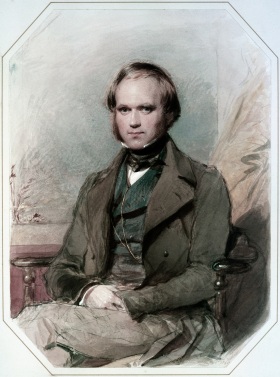
Charles Darwin, by George Richmond
- (3) “When we treat of sexual selection we shall see that primeval man, or rather some early progenitor of man, probably first used his voice in producing true musical cadences, that is in singing, as do some of the gibbon-apes at the present day; and we may conclude from a widely-spread analogy, that this power would have been especially exerted during the courtship of the sexes, – would have expressed various emotions, such as love, jealousy, triumph, – and would have served as a challenge to rivals. It is, therefore, probable that the imitation of musical cries by articulate sounds may have given rise to words expressive of various complex emotions.” (Darwin, The Descent of Man)
The first musical “instrument” was obviously the voice of man who, even before he could master speech, had a vast range of expressive sounds: imitating natural sounds, plus singing, humming, whistling (a gamut of styles), shouting, crying, laughing, coughing, yawning, or producing various sounds through the mouth. (See Darwin’s The Origin of Species on music and speech). Add motion to all of these sounds: not only dance, but also grimaces, gestures and movements of individual body parts (head, arms and legs). In like manner, the first percussion “instruments” were hand claps, finger snaps, stones, wood and whatever could be used to accentuate rhythm. Man-made instruments would appear much later when humans started making tools.
By the way, let me make clear that talking about “humans”, I refer, in fact, to the Hominini. The oldest tools found in Tanzania were made 2.6 million years ago, i.e. before the emergence of the various human species (Homo). We suppose that the first tools were made by Australopithecus, who then transmitted this knowledge to Homo habilis. Our ancestors proceeded to the next phase of tool-making 1.7 million years ago with Homo erectus. (See the Chronicle 3, where this theory is disputed). I maintain, therefore, that sound preceded speech and that music, song, a capella (with no instrumental accompaniment), emerged together with voice as a characteristic of some Hominini, or even Hominids. Besides, we know for sure that music was not born with modern humans (Homo sapiens) – who, as they say, were musically not as talented as the Neanderthals!
The Singing Neanderthals, according to Steven Mithen.
In the beginning was the sound: music precedes speech.
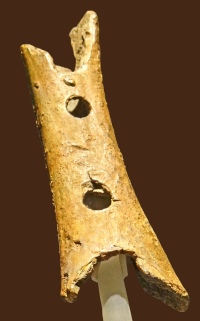
The oldest musical instrument: the Divje Babe flute (Slovenia) possibly made by the Neanderthals
In his study The Singing Neanderthals / The Origins of Music, Language, Mind and Body, Steven Mithen, an archaeologist and professor of early prehistory at the University of Reading in England, expands mainly two ideas: a) the parallel development of what modern man calls music and language, and b) his original idea that the Neanderthals had a peculiar proto-music/language: it was holistic (not composed of segmented elements), manipulative (influencing emotions and hence behaviour of oneself and others), multimodal (using both sound and movement), musical (temporally controlled, rhythmic, and melodic), and mimetic (utilizing sound symbolism and gesture) – i.e. “a pre-linguistic musical mode of thought and action.” That is why, as Manuel de Falla and Federico García Lorca said, “many suppose that chanting is the earliest form of language”, or that song is older than speech. Prosody (“melos of speech”, according to Aristoxenus), was the “melody” produced during ancient Hellenic speech, which was musical, not dynamic as it is now (see Chronicle 6, footnote 6, and Chronicle 12, footnote 7).
Music as the Mother of Speech
-
● Music (singing) as the Mother of Speech (language) is an idea shared by Darwin, Jean-Jacques Rousseau, Johann Gottfried Herder, and Wilhelm von Humboldt.(4) We get an idea when we examine the pronunciation in several languages. Closer to the original source are tonal languages, such as Chinese, where each syllable is uttered with a different note or pitch. Then it’s the pitch accent languages, such as ancient Hellenic, where only the stressed syllable is uttered at a higher note-pitch. According to Dionysius of Halicarnassus, the interval between the accented and non-accented syllables reached to an anything but negligible fifth interval (e.g. E-B, see Chronicle 12). Additionally, there are dynamic languages such as modern Greek with the stress given through an increased volume of the voice, not a higher pitch. The difference with ancient Hellenic is obvious in poetry where the accents had no effect on the poetic metres, as they would if the stress were dynamic. The poetic rhythm was musical, prosodic (alternating long and short vowels), and not dynamic. Poetry was musical, having melos (the melody of pitch accent) and rhythm (with long and short movements).
- (4) Except Rousseau, Herder, Humboldt, Darwin, Falla and Lorca, many other authors have been led to suppose that word and song had once been the same thing – of course, after the word was germinated by the song.
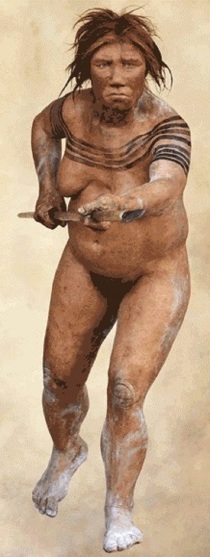
An aggressive Neanderthal woman is rather misleading since, according to National Geographic, the genes linked to modern man’s aggressive behaviour were probably absent in the Neanderthal DNA. This may explain their disappearance…
In her review on this book, Ellen Dissanayake, of the University of Washington in Seattle, initially lists the vast ocean of knowledge such a study like Mithen’s requires: evolutionary theory; human evolution (social lifestyle, environment); palaeoarchaeology (linguistic and musical abilities and their development); anatomy (ear, vocal tract, brain and musical capacities); neurobiology (brain chemistry, musical cognition and emotion, neuroanatomy of music); origin and evolution of language (similarities and differences with music, semantics, syntax, prosody); music-like communication systems in some other animals (non-human primates, whales, birds, etc.) and their relevance to human communication; music psychology and linguistic behaviour in children; ethnomusicology; the art and practice of music; and the findings of music therapy and the psychology of musical emotion. I can also mention biomusicology or evolutionary musicology.
“Singing Neanderthals”, according to Mithen, had a vocal tract and respiratory control that could have enabled speech, but perhaps they lacked the neural network that was necessary for language. This means that in the beginning was the sound: music preceded speech. Moreover, pre-sapiens hominids, such as the Neanderthals, perhaps lacked metaphorical thought – the ability to have in mind at the same time information from several different cognitive domains. Symbolic artifacts have not yet been found in their dwelling sites, indicating absence of symbolic thought and hence symbolic utterance: spoken language. But the harsh realities and challenges faced in such a hostile environment during the Ice Age required complex emotional communication and cooperation. Therefore, they developed a “music-like communication system that was more complex and more sophisticated than that found in any of the previous species of Homo”. Mithen emphasizes the importance of “emotional intelligence” – the ability to express one’s feelings with face, voice, and body, and decode the emotional signals of others.
It’s impressive that singing was preferable to talking. Why were the symbols of spoken words less reliable than an emotional melody? What were the pros and cons of language?
What is language? What’s its origin?
WE READ THE ABOVE QUESTIONS at the gate of a Congress Palace, the venue of a thought-provoking international symposium. Intrigued by this notice, we go inside and there we hear everyone disagreeing with everyone else! But still, there is a recurring theme of almost paramount consent – something that escaped even Darwin’s attention: a prerequisite, they say, for the emergence of language is that there must be trust within the tribe (what we now call “society”)! Meaning that some kind of social transformation generated unprecedented levels of public trust, liberating this way a potential for linguistic creativity, which was dormant until then. Under normal conditions, as the saying goes, “words are cheap”, “double-talk”, i.e. unreliable symbols on which the tribe could not count for survival; in other words, language was not trusted to become an evolutionarily stable strategy.
When a cat purrs, we mostly feel sure that the animal is content. We trust the signal because it just can’t fake that sound. Vocal calls of the primates may not be so trustworthy. Their social intelligence is characterized as “Machiavellian” – self-serving and without moral scruples. Monkeys and apes often attempt to deceive one another, while at the same time remaining constantly on guard against falling victim to deception themselves! Paradoxically, this very trait is theorized as blocking the evolution of a language-like communication among them! A verbal signal sounds like the cry “Wolves!” by a shepherd trying to fool the others in the well-known moralizing pedagogical story. Once proven false, nobody takes it for granted anymore or even cares. Therefore, socially reliable institutions are necessary, where every scoundrel, “monkey” or “shepherd”, is accountable. In a hunter-gatherer society, a basic mechanism inspiring trust is the collective ritual. (In our society, all the above adequately explain our crisis).
Baby talk and the embryo’s audio stimuli
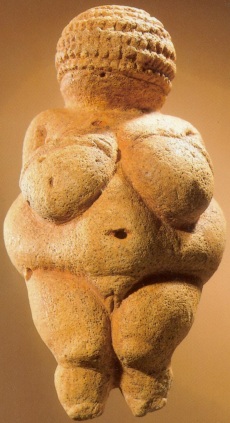
No features on “Venus” of Willendorf (28.000-25.000 BCE), only reproductive: probably she was a Mother Goddess
Last but not least is what we call “baby talk” – not the talk of a baby still unable to speak, but the one used by adults (usually mothers) while addressing infants, touching and caressing them: a melodic and undulating language, combined with strong gestures, exaggerated facial expressions and rhythmical head and body movements. This is indeed a language because the baby understands the meaning of all these sounds and movements: that is, comprehends the mother’s intentions. In this sense, such a language is similar to music having two main functions: to strengthen the mother-child relationship, and help the infant to speak. In this way its chances of survival increase. Man’s ability to synchronize himself with an external pulse – which is probably unknown to other mammals, including primates – was derived from the primordial mother-infant interaction that in time transformed itself into a proto-music/language – à la Neanderthal!
“Baby talk” has a similar “lexicon” in all cultures. The way mothers and babies raise and lower their voices, change simultaneously expressions and move their hands, is equivalent everywhere, despite linguistic differences such as between musical and dynamic languages. The reasons may be genetic or environmental – in the sense that all embryos grow in a similar environment and can hear twenty weeks before birth, far longer than other animals, most of which cannot hear before birth. During these weeks, the human fetus can also perceive movement and orientation. In addition, it senses the emotional state of the mother via the internal sounds of her body (voice, heartbeat, footsteps, digestion, etc.) and in this way adjusts its postnatal demands (e.g. crying), improving the chances of its survival. The embryo’s capacity to learn and remember sound patterns seems to confirm the idea. In this case, the internal sounds of the human body, and their relationship with the emotional state, may be associated with the relationship between audio-rhythmic patterns in music and their strong emotional charge.
“The human being is musical by man’s very nature”. (Iégor Reznikoff)
-
“MAN”, IÉGOR REZNIKOFF REMARKED,(5) “is a speaking being. However, I am absolutely sure that he is also a musical, a singing being, like birds. We know that the various species of birds are also distinguished by the way they sing. The same happens with humans who are distinguished not only by their speech, but also by their singing.
- (5) Reznikoff’s remarks were recorded by Despoina Paisidou-Lazaridou in Delphi in 1986 for the radio program, Living and Learning (ERT3). It was the time I started “sailing” on the airwaves as a “chronicler”, presenter, and also music supervisor, during the first round of the program on the Chronicle of Music. Nevertheless, the making of a radio program was something that I learned watching the producer Katy Vlachou with her immense patience and also open mind: she let me present in a public mass medium what I was not allowed to do at the time in a… private one (the newspaper Thessaloniki).
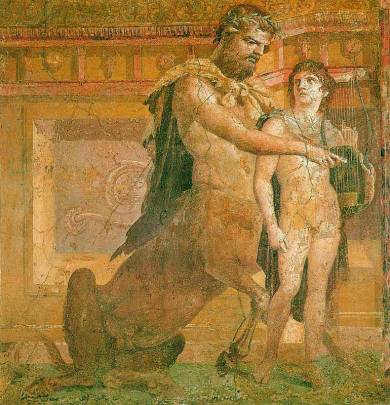
The Education of Achilles by Chiron (fresco from Herculaneum,
a city more wealthy than neighbouring Pompeii)
-
“These features, I believe, are part of human nature. They are deeply connected with man’s organic nature – his ears and throat, that is, his vocal capacities. That’s how he is born and created since his conception. A child e.g. can hear even when it is in the womb of its mother as a fetus and remembers some elements of music and the voice of its mother or her song.(6)
- (6) “Voices and audio stimuli to which a fetus is exposed during pregnancy are not only perceived but also recorded in its memory”, a scientific team concluded in a study. “Thus, if as a fetus it listened to soft music of natural instruments, as an infant it immediately calms and quiets down under the same sounds, while another baby, who had no such experience when it was in the belly of its mother, keeps on screaming”…
Music activates the brain’s centres of communication
-
● Besides, except the “Singing Neanderthals”, there are also “Singing Embryos”! A research showed that fetuses react to sound stimuli and “sing”! Some researchers at Institut Marquès in Barcelona showed that a fetus can detect sounds and even react moving its mouth and tongue, proving that the ears of the embryo are fully developed by the 16th week of pregnancy. The leading researcher said that the fetuses responded to music moving their mouths as if they were trying to talk or to sing. Music activates the parts of the brain associated with communication, and when the embryos hear it, they react with movements similar to those of a cry, which is the first stage before speaking and singing.
-
“Music is deeply rooted in humans. Singing is a characteristic of the human species. It is not something recent in man’s social life. The mechanism of hearing and its relationship with speech is characterized by complexity and is located deep inside the brain. Thus it cannot be something recent. In short: the human being is a musical being by man’s very nature.”
Generally speaking, the different species are born as tabula rasa regarding those qualities to be acquired – i.e. that must be gained after birth, depending on the current conditions faced by each species for its survival. But they bear in their DNA all those inherited capacities and qualities that have emerged as acquired ones (upright position, articulation, etc.) and ensured the survival of the species during the millennia of its evolution. This is where all the wisdom of the past is stored – together, of course, with natural musical capacities.
“Musical ear”: a characteristic of the majority or of a minority?
Despite all that, we know that talent, an innate musical inclination, or a “musical ear”, do not characterize all persons but rather a minority. How come that some of them can sing beautifully or at least correctly, while others, who equally love music, sing out of tune?
-
“There is innate musical disposition, musical talent, which is often hereditary: see the Bach family”, said professor Demetris Thémelis “But in general terms, everyone can learn music up to a point. Most people sing out of tune because they’ve had no proper musical education, except in some cases where they may have some physical problem e.g. hearing impairment. Or they may listen properly and have some feel for music, but face some problem in the larynx muscles. There are many cases of distinguished musicians, productive composers, who are ‘cacophonous’, i.e. they cannot sing well because of such problems.”
This may be so, but then how come that in the Third World and, moreover, in the countryside, anywhere far from metropolitan urban centres, i.e. wherever children are naturally brought up, almost everyone can sing and dance well? Here’s Ellen Dissanayake’s comment:
-
“It is not spoken language itself that overlays or stunts musical ability”, she said, “but the factors in modernized societies that have made music a specialty – individuality, competitiveness, compartmentalization, institutionalization – reinforced by the high degree of literate (not oral improvisatory) training required to read (and compose) musical scores as well as literary texts. In small-scale pre-modern societies (and in any large modern sub-Saharan African city, as well in children anywhere who are exposed customarily to frequent communal musical activity), everyone participates in music – regularly, spontaneously, and wholeheartedly – and benefits thereby from the many adaptive advantages” it offers.
You can see, therefore, how crucial is the role of the mother, as well as that of the family, or social environment in general, for the development of a child’s innate musical inclination. This must be the explanation for the existence not only of musical families, but also of musical tribes among gypsies or blacks. Not everything is hereditary, in spite of the important role of heredity: the potential capacities must be cultivated; otherwise they remain dormant, inert, like some atrophic member.
-
“We can say that African Americans have this divine gift”, said Reznikoff, referring to the innate inclination, the special talent. “Africans have a long tradition in music and singing. Furthermore, they have kept some primitive ways of expression and emotion, and thus they are probably closer to antiquity. The ancient Greeks also loved singing and dancing very much, as the Arabs do now.”
-
“Since we are human beings, with the senses of audition and vision, it happens that we have constants in art. These constants in music have to do with the natural laws of resonance and consonance: when a chord vibrates, it follows the laws that govern the sound, producing sounds and harmonics that delight our ears; so, our bodies respond.
-
“It is striking that an instrument like the cithara is found in all cultures. The behaviour of a string and our bodies is the same everywhere. Something similar happens with the auloi. Note that these instruments have been used in several ways in all cultures. But with few exceptions, and apart from modern Western civilization, we see everywhere the same musical laws to apply. It is a global concept of consonance precisely because we are dealing with a natural law.
-
“This concept, nevertheless, was lost since the early 19th century when the piano was introduced into music changing the natural tuning of the instruments; for the piano is tuned differently, with the equal intervals of the tempered scale. This tuning is wrong if we consider it from the point of view of natural resonance. It is due to the enormous development of music – but a kind of cultivated, sentimental, conceptual music which has abandoned its natural foundation that is rooted in our body and soul.
-
“Something equivalent has happened in painting: we have ancient art, or iconography, and then we have the art of beauty, even if it depicts saints, or Theotokos: Raphael’s Madonna is really beautiful, her movements are beautiful, and art lies in this beauty, not in the power exerted deep inside your soul by an icon. We have lost these deep roots related to our biological bodies – because we must not forget we are material beings obeying to natural laws. Nowadays art is too conceptual as e.g. abstract art, or even electronic music with computers.
-
“In antiquity people had delicate, fine ears catching all nuances. The lyre was a ‘soft’ instrument, just like those old traditional ones. When one listened to music on those instruments, he used his spirit even more: let us remember the long texts of old songs. Now, of course, we have all these huge pieces of machinery with the many decibels! All instruments are amplified and modified for that purpose. The violin is already a ‘hard’ instrument like the piano.
-
“I, personally, believe in a natural approach of antiquity – without imitating or copying it. We must go back to the delicate acoustics of antiquity, because finally man remains the same body and soul. These natural laws – so rich that they have created all those cultures – are like oxygen for us. In the big cities, of course, we may live in air pollution but we are not made for this: it is better for us to breathe fresh air…
-
“Music’s purpose in antiquity was not just fun. It mainly had to do with the invisible world. This is also true for the Pythagoreans, and later for the Platonic school, or even previously for the Orphic tradition, which influenced the Christian Church. For the Orphic tradition, music actually serves as a link to the invisible: for the preparation of the journey of the soul after death to eternity”…
The “labyrinth” of Reznikoff’s thought, or the contraposition between “soft” and “hard” instruments, may confuse us. The key to grasp its essence lies in that apt example from the art of painting. Sweet melodies and gentle voices, e.g. in most lullabies, are the equivalent to Raphael’s Madonna. Quite the contrary was what Plato suggested about children that cannot go promptly to sleep: “mothers do not offer them peace, but movement instead, always rocking them in their arms, not silently but with some melody, and in this artless way they make the kids fall asleep”. If you experiment, they say, you will see that the… Platonic technique is highly effective!
Catharsis: the mental and moral purification through Dionysian ecstasy.
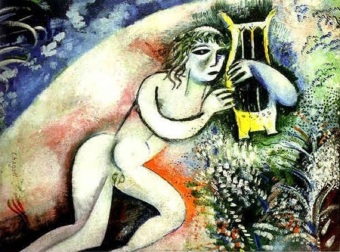
Orpheus, by Marc Chagall
A SIMILAR MISUNDERSTANDING seems to obsess psychotherapists who choose music with soft sounds, having waters trickling and birds singing as… garnish in the background. But what the ancients were after during their psychotherapeutic rituals was exactly the opposite with their deliberately intense and monotonously repetitive music.
Using suitable melodies and rhythms, they made the mentally disturbed person to flush to such a degree that a reaction would follow bringing him back to his previous normal condition. Such methods of “sorcery” survived even in the so-called “civilized” world until the 60s. Certainly, now that we have become so very “cultured”, musical sounds can hardly excite us…
“Fire cleanses, while water purifies”, said Plutarch. Catharsis was the mental and also moral purification through Dionysian ecstasy in ancient Hellas. This is the original meaning of the term; not the one used in periods of political corruption in modern Greece. According to Aristotle, it was what the audience in a tragedy was subjected to through feelings of pity and fear caused by the suffering and tragic end of the heroes.
-
“There was a close link between the swamps (as sources of infections and fever), the subsequent neuromental disorders and their cure with music in the therapeutic rituals of the Corybantes and the Bacchantes”,(7) wrote Denise Jourdan-Hemmerdinger in the synopsis of her paper on Music in the Therapeutic Rituals of the Corybantes and the Bacchantes, at the Musicological Symposium at Delphi in 1988.(8) “These data allow a better reading of ancient texts. We can reconstruct them not anymore in an entirely irrational context with widespread mysticism, but in a reality with tragic experiences in the time line.
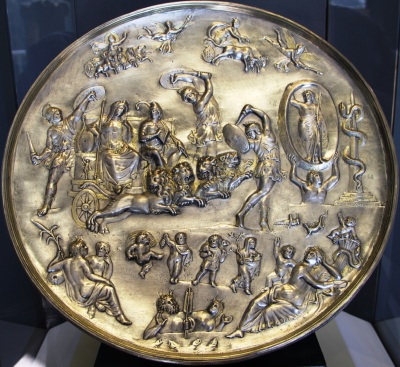
Cybele and Attis, three Corybantes, Aeon, Helios, Selene, Phosphorus, Hesperus, Poseidon, Thetis and Gaea,
on the Parabiago plate (2nd-4th century AD).
- (7) Corybantes: Cybele–Rhea’s priests in Phrygia, connected with Dionysus-Bacchus, performing orgiastic dances accompanied by cymbals, rattles, auloi, tympana (tambourines) [> corybantism (catharsis)]. We have already seen Dionysus’ followers, the Bacchantes, Bacchae or Maenads (< mania), as Orpheus’ slayers (in Chronicle 12, footnote 3).
- (8) With this… Sibyllic synopsis, Jourdan-Hemmerdinger tried to give some idea to the audience about her paper. Unfortunately, she had a formidable opponent: relentless time. Within a very short time – granted to each speaker – she had to expand on her vast thesis that could be the subject of a separate symposium. The… machine gun tempo she chose to say “everything” in time eventually proved to be a boomerang for her extremely interesting topic.
-
“So the biological and pathological cause of hallucinations reappears as an archetype of the mythological and dreamlike world of fantasy. Although the monotheistic religions expelled the ancient gods, who played a therapeutic role, they did not eliminate malaria – a scourge as old as the world but always present. This Thraco-Phrygian and Orphico-Pythagorean music therapy survived more or less in some folk, religious, pagan traditions.
-
“What did these specific kinds of music consist of? What body and soul level did they act upon? How and why were they effective? The texts give us an idea. Can we get even further? Obviously, if we work on this rich and diverse file with a fortunate conjuncture of data of the geographical and ethnological hematology, and medical anthropology – sciences already containing a wealth of information – adding the results of ethnomusicological research, without forgetting ancient and medieval musicology, either Oriental or Occidental.”

Bacchic Dance of Maenads in a Wood,
by Gustave Doré
Ethnological, musicological and medical research was eventually carried out in Asia (India, Indochina, Siberia), Africa (Ethiopia, Senegal), America (Haiti, Native American Indians and Eskimos), and Europe. Such phenomena were observed in Magna Graecia, especially around Taranto, with the renowned tarantella dance that was a key element of the musical exorcism to counteract the poison of the tarantula spider.
Part of the same tradition is a – mostly – Thracian fire ritual, called anastenária (nestinarstvo in Bulgarian Thrace). The oldest written information about such barefoot dances on smoldering embers is found in Euripides’ The Bacchae. Later Strabo wrote about Artemis’ priestesses in Asia Minor and Italy performing such dances at will. In Byzantium the dancers were called “psychária” or “asthenária” (hence anastenária or nestinari), while around 1800 such rituals were prevalent not only in the Balkans but also throughout Anatolia.
Music and dance contribute to an emotional release
and thus have a therapeutic effect on the participants.
Anastenária’s most striking feature is probably the “incombustibility”, “immunity from fire” – the (seeming, at least) negation of a natural law. This element of the ritual stirs our imagination so much that almost everyone forgets to mention the key role of music and dance which, according to many experts, contribute to an emotional release and, in this way, have a therapeutic effect on the participants. In a sense, therefore, this ceremony is a psychotherapeutic ritual system.
 Levi-Strauss believes that these systems provide the patient with a gateway to express inexpressible conditions. During this therapeutic process, the participant receives from outside a social myth that has no conflicts and, therefore, does not correspond to his previous personal condition. In such a context, reality is compelled to identify with this social myth. Without music and dance, however, methexis is not possible:
Levi-Strauss believes that these systems provide the patient with a gateway to express inexpressible conditions. During this therapeutic process, the participant receives from outside a social myth that has no conflicts and, therefore, does not correspond to his previous personal condition. In such a context, reality is compelled to identify with this social myth. Without music and dance, however, methexis is not possible:
-
“Monotonous music”, the psychiatrist Constantinos Constantinides wrote in his Notes on Fire Walking of Anastenária and a Possible Explanation of Incombustibility, “is a prerequisite to a change of mental mood, creating an equivalent emotional state, and triggering the subcortical (motor and emotional) centres, so as everything is easily and automatically executed, eliminating the inhibitory effect of the cortex.
-
“Generally motivated also by music, dance is known as a largely automatic event and as such a new prerequisite to the creation of the whole mental ecstatic state – even more so if it is religious. That is why all primitive religions are ‘danced’, all happy events are ‘danced’. While dancing, there is a peculiar emotional state, there is more automation and unconscious function, and there is more or less self-absorption and a break of contact with the environment. One could say that dance is a certain step to ecstasy, opens the way to the phenomenon of ecstasy.”
“Dance is a certain step to ecstasy, opens the way to the
phenomenon of ecstasy.” (Constantinos Constantinides)
-
“Music particularly seems to coordinate a tendency to group unification”, commented another psychiatrist, Pantelés Kranidiotes, analyzing Anastenaria as a Psychosomatic Phenomenon. “Constantinos Romeos realized just that, commenting ‘music makes the human soul to feel such desolation that it desires to mingle with the other dancers seeking to let it go’. On the other hand, Polydoros Papachristodoulou underlines the impact of music on these people saying that music ‘exerts some particular influence on the nervous system of hysterical, naïve peasants’.
-
“But anyway, regardless of the quality of the receiver, everyone would perceive this fascinating power of music, if above all he experienced the crucially overwhelming davul in the ‘hangout’, where ‘all the spectators were agitated and rocked’ under its sounds.
-
“Emotional arousal is more secure when music is more familiar. This is obviously the purpose of conflating this religious ceremony with songs, which clearly translate the various deepest emotions of the people’s psyche and where above all is the dominion of heroic elements, which can only bring about an arousing, wild ecstasy.
-
“This combination seems much more effective to induce the required emotional orgy than the ecclesiastical chants and hymns, which are totally absent in this religious ceremony, as they produce a rather static ecstasy.
-
“The music of the fire dancers, familiar to them over the centuries, is a creation and property of their own emotional universe and that is why it can definitely stir it and indeed with an intensely arousing way.(9) But here it seems that rhythm plays the main role in music and – as the musicologist Pantelés Kavakópoulos says – ‘what excites the fire dancers is the davul with its varying rhythms’.”
- (9) These psychiatrists, it’s obvious, look on the fire dancers “from on high”: they see “hysterical, naïve peasants” with “the people’s psyche”, immersed in “an arousing, wild ecstasy”, which is described as an “emotional orgy”, under the sounds of a music that is a “property of their own emotional universe”… They recognize, however, that the impact of this music and dance, in that particular environment, is equally catalytic “regardless of the quality of the receiver”, apparently having in mind that nowadays, among fire dancers, several “hysterical, naïve”… intellectuals and scientists are included!
First a fetus hears mother’s heartbeat. The pulse is recorded deep in
the brain; when excited, man’s inhibitions are neutralized, and he is
in ecstasy, acting not as an individual but as a member of a group.
RHYTHM, INEXTRICABLY connected to dance, is the first musical element man experiences. The initial sound a fetus hears is the mother’s rhythmic heartbeat, long before it enjoys her singing – if she has a sweet voice. But even if she doesn’t, this primary pulse is recorded deep in its mind, in the subcortical centres of the brain; when they are excited, man’s inhibitions are neutralized and, as a result, he is overwhelmed with ecstasy, acting as a member of a group and not as an individual.(10) That’s why melody, the second element of music, is intentionally monotonous and persistently repetitious, while the lyrics, if it’s a song, are just as rudimentary: precisely to prevent the re-activation of the cortex and achieve the culmination of ecstasy.
- (10) Music has been my first occupation, since I was 15, playing in the band of my father, Iannes Loukovikas. I remember that, also due to my music education, I wondered, and was annoyed, as well, whenever an audience glorified some drummer, or anyone playing percussion, in his solo, although his performance was not as difficult as the other musicians’ who, nevertheless, never received such an ovation. The answer to this childish question of mine is given here…
Such phenomena could not go unnoticed by ancient Greek philosophers, who have testified how crucial the role of rhythm is for the preservation, modification or loss of ethos in music. Socrates, Plato, Aristotle and many others investigated the ethos in rhythm, melody, genera and harmonies or modes, not only because music was the foundation of education, but also because – quite rightly – they considered music as a form of language, capable of expressing almost as much as speech and exerting a catalytic effect on people, especially the youth.
Ethos of music (rhythm, melody, genera,
modes): exuberant, restrained, or serene.
-
“No act among people is performed without music”, Aristides Quintilianus used to say, while Plutarch stressed that “the formation and preparation [of young people] to be good [citizens is achieved] through music”, for the Orphean art is really beneficial “on everyone and every well-instructed act”, concluding: “Foul music and wicked songs lead to prodigal morals and unmanly lives, and men to indulgence and flabbiness and effeminacy”…
The ethos of music was generally distinguished as exuberant (the one causing agitation or excitement); restrained (the opposite); or serene (that calms down). Comprehensive philosophical studies were apparently based on observations on ancient folk rituals, such as musical therapeutic ceremonies. The philosophers found that every rhythmic or melodic movement resulted to certain emotional reactions, positive or negative – depending on the intended purpose. Thus they concluded that the sounds with the beneficial effects should be praised and the others to be condemned.
It was natural that the concept of ethos was also exploited for the condemnation of musical innovations by the conservatives, as we have already seen (Chronicle 12. “Do not maltreat our music!”). But in no way does this fact mean that musical ethos is worthless. Why else should the idea be adopted by Persians and Arabs and so many others?
“OK, if it’s not worthless, it is certainly completely unknown today”, the dissidents counter-argue. “Why should we care about the ethos of music (and not only) in an exceptionally unethical era in every respect? Isn’t it… an anachronism?”
Dear reader, my dearest fellow voyager, don’t you think that having come thus far, it means there is a deeper reason in earnest?
●
.
After the Mediterranean periplus, in search of Orpheus,
we set sail to Tartessos, in the Cassiterides archipelago…
Let’s follow the… tin!
Next Chronicle 15. SAILING TO RIO DE JANEIRO! (Crossing the Atlantic / So Distant, So Near) ● Periplus – Luso-Hellenic Wanderings ● An Atlantic Odyssey
Some content on this page was disabled on 2024/03/08 as a result of a DMCA takedown notice from Julian Jarosch. You can learn more about the DMCA here:


